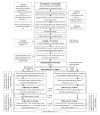Evaluation of a Web-Based Tailored Nursing Intervention (TAVIE en m@rche) Aimed at Increasing Walking After an Acute Coronary Syndrome: A Multicenter Randomized Controlled Trial Protocol
- PMID: 28450272
- PMCID: PMC5427251
- DOI: 10.2196/resprot.6430
Evaluation of a Web-Based Tailored Nursing Intervention (TAVIE en m@rche) Aimed at Increasing Walking After an Acute Coronary Syndrome: A Multicenter Randomized Controlled Trial Protocol
Abstract
Background: Despite the health benefits of increasing physical activity in the secondary prevention of acute coronary syndrome (ACS), up to 60% of ACS patients are insufficiently active. Evidence supporting the effect of Web-based interventions on increasing physical activity outcomes in ACS patients is growing. However, randomized controlled trials (RCTs) using Web-based technologies that measured objective physical activity outcomes are sparse.
Objective: Our aim is to evaluate in insufficiently active ACS patients, the effect of a fully automated, Web-based tailored nursing intervention (TAVIE en m@rche) on increasing steps per day.
Methods: A parallel two-group multicenter RCT (target N=148) is being conducted in four major teaching hospitals in Montréal, Canada. An experimental group receiving the 4-week TAVIE en m@rche intervention plus a brief "booster" at 8 weeks, is compared with the control group receiving hyperlinks to publicly available websites. TAVIE en m@rche is based on the Strengths-Based Nursing Care orientation to nursing practice and the Self-Determination Theory of human motivation. The intervention is centered on videos of a nurse who delivers the content tailored to baseline levels of self-reported autonomous motivation, perceived competence, and walking behavior. Participants are recruited in hospital and are eligible if they report access to a computer and report less than recommended physical activity levels 6 months before hospitalization. Most outcome data are collected online at baseline, and 5 and 12 weeks postrandomization. The primary outcome is change in accelerometer-measured steps per day between randomization and 12 weeks. The secondary outcomes include change in steps per day between randomization and 5 weeks, and change in self-reported energy expenditure for walking and moderate to vigorous physical activity between randomization, and 5 and 12 weeks. Theoretical outcomes are the mediating role of self-reported perceived autonomy support, autonomous and controlled motivations, perceived competence, and barrier self-efficacy on steps per day. Clinical outcomes are quality of life, smoking, medication adherence, secondary prevention program attendance, health care utilization, and angina frequency. The potential moderating role of sex will also be explored. Analysis of covariance models will be used with covariates such as sex, age, fatigue, and depression symptoms. Allocation sequence is concealed, and blinding will be implemented during data analysis.
Results: Recruitment started March 30, 2016. Data analysis is planned for November 2017.
Conclusions: Finding alternative interventions aimed at increasing the adoption of health behavior changes such as physical activity in the secondary prevention of ACS is clearly needed. Our RCT is expected to help support the potential efficacy of a fully automated, Web-based tailored nursing intervention on the objective outcome of steps per day in an ACS population. If this RCT is successful, and after its implementation as part of usual care, TAVIE en m@rche could help improve the health of ACS patients at large.
Trial registration: ClinicalTrials.gov NCT02617641; https://clinicaltrials.gov/ct2/show/NCT02617641 (Archived by WebCite at http://www.webcitation.org/6pNNGndRa).
Keywords: Internet; Self-Determination Theory; Strengths-Based Nursing Care; acute coronary syndrome; computer-tailored; eHealth; nursing intervention; physical activity; secondary prevention; walking.
©John William Kayser, Sylvie Cossette, José Côté, Anne Bourbonnais, Margaret Purden, Martin Juneau, Jean-Francois Tanguay, Marie-Josée Simard, Jocelyn Dupuis, Jean G Diodati, Jean-Francois Tremblay, Marc-André Maheu-Cadotte, Daniel Cournoyer. Originally published in JMIR Research Protocols (http://www.researchprotocols.org), 27.04.2017.
Conflict of interest statement
Conflicts of Interest: Granting of licensing options for marketing VIH-TAVIE will follow study completion.
Figures
References
-
- Ko DT, Newman AM, Alter DA, Austin PC, Chiu M, Cox JL, Goodman SG, Tu JV, Canadian Cardiovascular Outcomes Research Team Secular trends in acute coronary syndrome hospitalization from 1994 to 2005. Can J Cardiol. 2010 Mar;26(3):129–134. http://europepmc.org/abstract/MED/20352132 - PMC - PubMed
-
- Statistics Canada Mortality, summary list of causes 2009. 2012. [2016-11-27]. http://www.statcan.gc.ca/pub/84f0209x/84f0209x2009000-eng.pdf .
-
- Writing Group Members, Mozaffarian D, Benjamin EJ, Go AS, Arnett DK, Blaha MJ, Cushman M, Das SR, de FS, Després J-P, Fullerton HJ, Howard VJ, Huffman MD, Isasi CR, Jiménez MC, Judd SE, Kissela BM, Lichtman JH, Lisabeth LD, Liu S, Mackey RH, Magid DJ, McGuire DK, Mohler ER, Moy CS, Muntner P, Mussolino ME, Nasir K, Neumar RW, Nichol G, Palaniappan L, Pandey DK, Reeves MJ, Rodriguez CJ, Rosamond W, Sorlie PD, Stein J, Towfighi A, Turan TN, Virani SS, Woo D, Yeh RW, Turner MB, American Heart Association Statistics Committee. Stroke Statistics Subcommittee Executive Summary: Heart Disease and Stroke Statistics--2016 Update: A Report From the American Heart Association. Circulation. 2016 Jan 26;133(4):447–454. doi: 10.1161/CIR.0000000000000366. http://circ.ahajournals.org/cgi/pmidlookup?view=long&pmid=26811276 CIR.0000000000000366 - DOI - PubMed
-
- World Health Organization Cardiovascular diseases. 2005. [2016-07-11]. http://www.who.int/cardiovascular_diseases/en/
Associated data
LinkOut - more resources
Full Text Sources
Other Literature Sources
Medical
Research Materials



